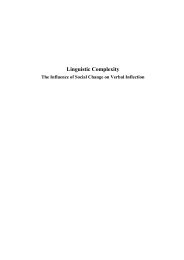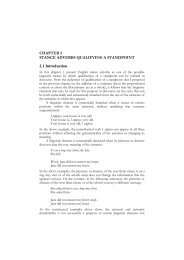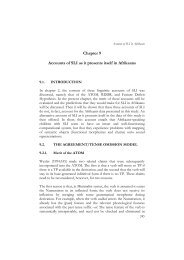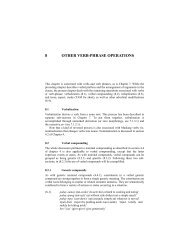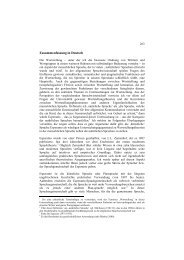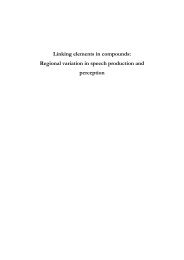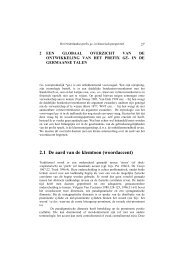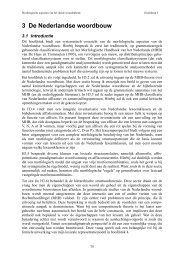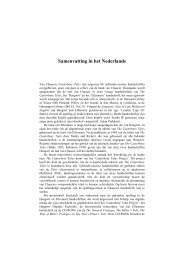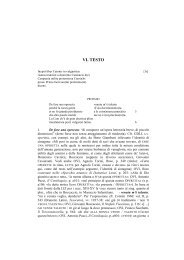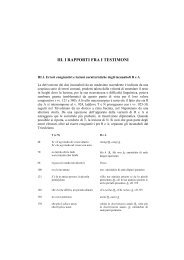Chapter 3 The Dutch Situation - LOT publications
Chapter 3 The Dutch Situation - LOT publications
Chapter 3 The Dutch Situation - LOT publications
Create successful ePaper yourself
Turn your PDF publications into a flip-book with our unique Google optimized e-Paper software.
<strong>The</strong> <strong>Dutch</strong> <strong>Situation</strong><br />
the description of the <strong>Dutch</strong> vernacular in the Latin school grammar Exercitium<br />
Puerorum, which notes as early as 1485 the syncretism of nominative and<br />
accusative (Van der Wal 1988: 246) Generally, however, grammars up to the 19th<br />
century were largely prescriptivistic and aimed at enrichment and improvement of<br />
the native language on the basis of the classical languages Latin and Greek. In<br />
particular, efforts targeted the inflectional morphology, especially case and gender,<br />
equating rich inflections with a high state of development. Improvement efforts<br />
involved the promotion of individual dialectal variants to standard forms, the<br />
reconstruction of earlier forms, as well as the invention of new distinctions. 2<br />
Inspiration was taken from the writings of highly valued authors from the past (see<br />
section 3.1.3) and the more conservative Flemish and Brabantian dialects in the<br />
south (Geerts 1966, but Van der Sijs 2004: 442). For the modern linguist, this means<br />
that neither the historical grammars nor the preserved literary texts can be trusted to<br />
provide realistic evidence about the colloquial language at a particular point in time. 3<br />
Moreover, what is now the <strong>Dutch</strong> language area used to be a conglomerate of quite<br />
heterogeneous spoken varieties whose documentation was not taken into<br />
consideration by the research agenda until recently. In the last decades, a few<br />
unbiasedly descriptive studies have appeared, e.g. by Van Leuvensteijn (1986, 1992,<br />
1997, Van Leuvensteijn and Dekker 1990), comparing 16th century diaries from<br />
Gouda in Holland and Brugge in West Flanders, as well as Hogenhout-Mulder and<br />
Van Reenen (1988), a corpus study of 14th century Gronings (the dialect of<br />
Groningen, now the northernmost province of the Netherlands). Generally, however,<br />
there is no comprehensive account of the diachronic facts. We can only speculate up<br />
to what period in time the three-gender system was alive in the various regional and<br />
dialectal varieties or in the developing standard language, what form its<br />
morphological exponents took and by which route it was replaced by the two-gender<br />
system of today. Yet, a short sketch should be attempted. <strong>The</strong> following section will<br />
give a rough account of what Middle <strong>Dutch</strong> gender morphology looked like,<br />
focusing on those properties of the paradigms that were to pave the way from a<br />
three- to a two-gender system.<br />
2 Some of these inventions survive to this day. One of the most prominent - debated<br />
among the educated public - is the distinction between hun (3rd person plural dative)<br />
and hen (3rd person plural accusative). This artificial functional split of two dialectal<br />
variants dates back to the grammar of Christiaen van Heule (1625) and it is still<br />
propagated by style manuals, although only a minority of writers manages to adhere<br />
to the rules consistently (Van der Sijs 2004: 478 ff, E-ANS § 5·2·5·2·3).<br />
3 Revealing hints can be found in statements such as the following from the<br />
grammar of Van Heule (1625) which gives a list of some 1500 nouns and their<br />
genders, but concedes that “Dit onderscheid der geslachten en behouft in den rijm<br />
altijt niet nagevolgt te worden, want om die oorzaeke zouden de Rijmers al te nouw<br />
gebonden zijn” ('this difference of the genders does not always have to be followed<br />
in rhyming, because this would constrain the rhymers too strictly’, 1625: 16).<br />
Kollewijn rightly interprets this statement as evidence for the artificiality of the<br />
gender distinctions expected in the written language (1916: 49).<br />
34



